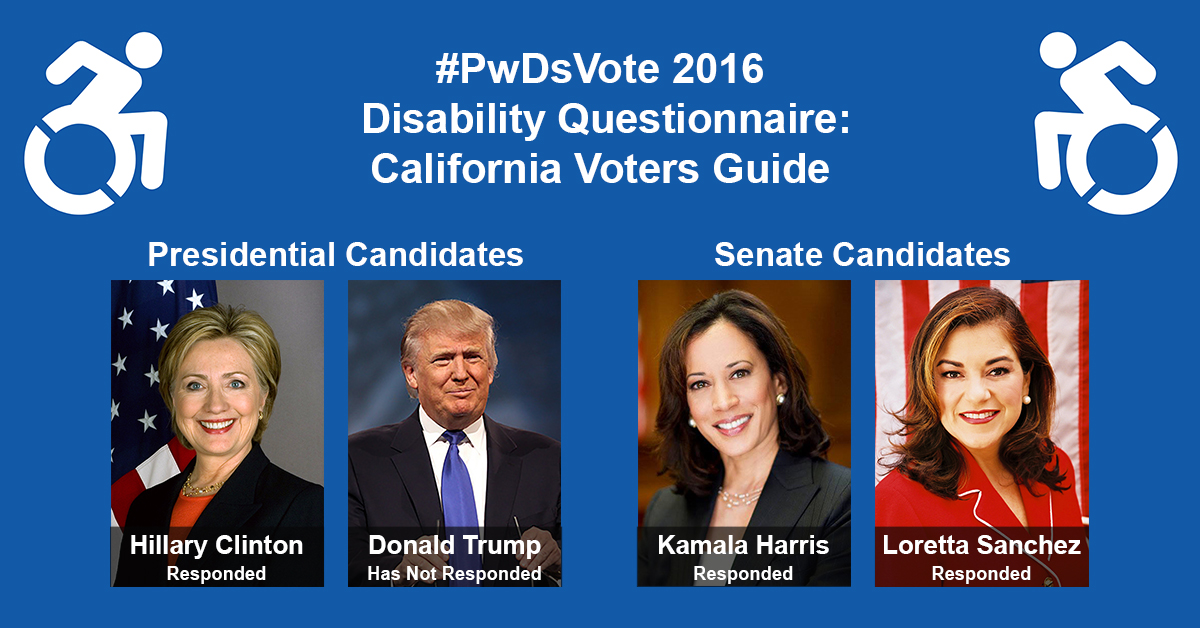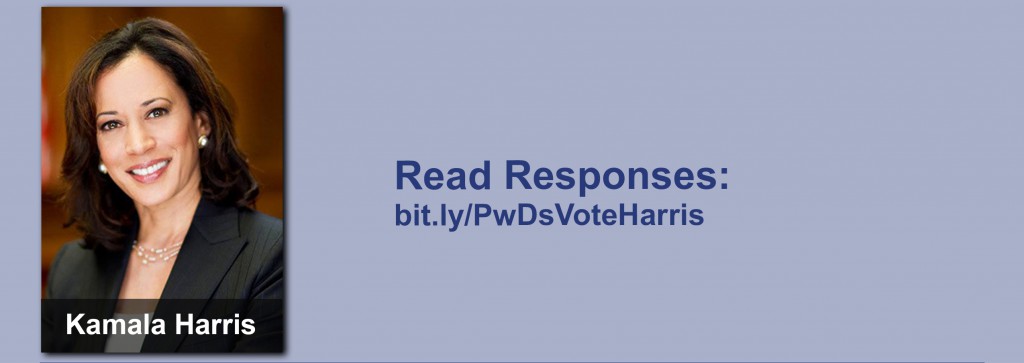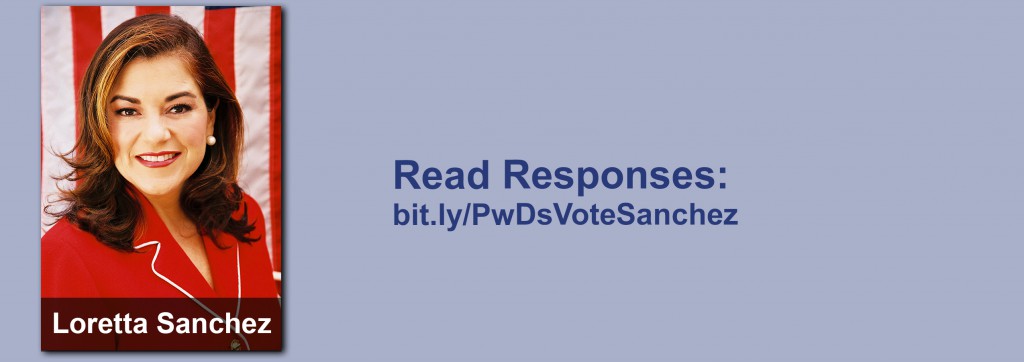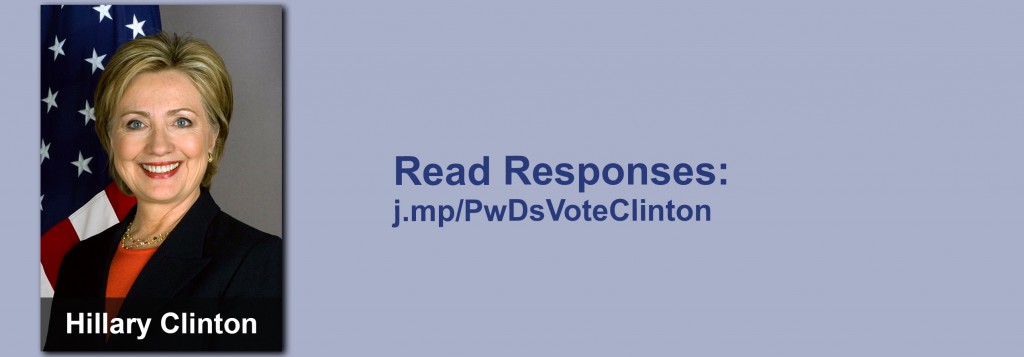Washington, Oct. 11 – As voters get ready to head to the polls in California, RespectAbility has released its California Disability Voter Guide. Democratic candidates Loretta Sanchez and Kamala Harris are seeking California’s open senate seat, and both of them, as well as presidential candidate Hillary Clinton, have completed the #PwDsVote Disability Campaign Questionnaire for people with disabilities and have very different solutions to pressing problems. By both Senate candidates filling out the questionnaire, each of them communicates that disability issues matter to them
The #PwDsVote 2016 Campaign Questionnaires were designed by and for people with disabilities (PwDs) and those who love them to know where candidates stand on key issues. RespectAbility is nonpartisan and does not endorse candidates. The questionnaires are purely for educational purposes as voters go to the polls.
According to a new report from Rutgers University, 35.4 million people with disabilities will be eligible to vote in the November 2016 elections, representing close to one-sixth of the total electorate. That’s an increase of nearly 11 percent since 2008.
The presidential questionnaire was created during the primary season and asked all of the presidential candidates to comment on 16 disability questions. Former Secretary of State Hillary Clinton responded by addressing all of the questions. Despite numerous requests in person and by phone and email, the Trump campaign has not yet filled out the questionnaire. The American Association of People with Disabilities and the National Council on Independent Living also has a nonpartisan presidential questionnaire, which both Clinton and Trump have completed. Libertarian Gary Johnson and Green Party candidate Jill Stein have not filled out either questionnaire.
The down-ballot survey was adapted from the presidential questionnaire to ask gubernatorial candidates 16 questions and senatorial candidates 17 questions. All answers are posted verbatim and in full on The RespectAbility Report, a publication that covers the intersection of disability and politics.
California has an open Senate race and both major-party candidates have responded, allowing the 4,019,882 citizens with disabilities a chance to compare them on a variety of issues.
Currently, California ranks 34th in the nation in terms of employment for people with disabilities; just 33.3 percent of working-age Californians with disabilities are employed. Moreover, there is a 38.9 point gap between the labor force participation rate of Californians with disabilities and those without disabilities. In order for outcomes to improve for people with disabilities, California’s voters need to be informed on where the candidates stand on issues.
In her response, Sanchez talked about how disability rights are important for making a better America.
“No American should be discriminated against because of a physical or mental disability,” she said. “To truly create an equitable world, we must eradicate the social stigma against people with disabilities. Disability rights are human rights.”
The Harris campaign also responded, speaking of her dedication to supporting legislation that further disability rights.
“As San Francisco District Attorney and California Attorney General, Kamala has a lengthy record of advocating for civil rights, including disability rights, women’s rights, racial justice, and LGBT equality,” the campaign said. “In the Senate, Kamala will continue her civil rights advocacy for persons with disabilities by ensuring that the ADA is fully enforced and that similar international laws, such as the Convention on the Rights of Persons with Disabilities, are given full effect.”
Fully one-out-of-five voters have a disability, and 52 percent of likely voters have a loved one with a disability. Only 34 percent of working-age Americans with disabilities have jobs, despite the fact that the vast majority want to work. More than 11 million working age people with disabilities are now living on government benefits in our country.
RespectAbility President Jennifer Laszlo Mizrahi said, “Our community is looking for jobs so we can achieve the American dream, just like anyone else. It is vital for us to know where the candidates stand economic, stigma, education, safety, transportation, housing, healthcare, foreign affairs and other issues. The candidates have hugely different ideas about how to deal with the issues. Thus, it’s extremely important to read their full answers so you can understand their vast differences.”
California Needs to Improve Outcomes for Citizens With Disabilities
There are 2,010,783 Californians with disabilities who are between the ages of 18-64. Additionally, there are 115,000 Californians ages 16-20 with disabilities. More than 613,000 California students have individual education plans (IEPs). However, many Californians with disabilities have not yet received a disability diagnosis they need, and thus are not yet receiving the school accommodations and supports that they need to succeed. Many students who might need support to succeed academically instead find themselves trapped into a lifetime of poverty or flowing down the school to prison pipeline.
Today California has the opportunity to work hard to improve outcomes in terms of competitive, integrated employment for people with disabilities. Currently only 33.3 percent of working-age Californians with disabilities are employed compared to 72.2 percent of those without disabilities. View the rankings of all 50 states and compare.
California has the opportunity to lead by example by including more people with disabilities in the workforce thanks to Workforce Innovation and Opportunity Act (WIOA). As the largest state in terms of population and economy, many other U.S. states look to California for guidance. WIOA gives California the opportunity to set the stage for all other participants and show that people with disabilities can be a valuable asset to any employer.
RespectAbility, founded in 2013, is a nonpartisan, nonprofit organization working to end stigmas and advance opportunities for people with disabilities. It has submitted comments for all 50 state’s drafts of the Unified Plan as required under Section 102 of WIOA. According to the current draft of California’s state plan, There are more than 115,000 youth with disabilities in California, and each year more than a quarter of them will age out of school into an uncertain future.
One of the most important facets of WIOA is that it raises expectations for youth with disabilities and assists states to provide them with the supports they need to ensure success. Indeed, as California’s Baby Boomers retire and your state’s economy evolves, employers are starting to experience increasing talent shortage. Californians with disabilities are an untapped resource that can be trained to bridge that gap. Indeed, a recent detailed study by the Kessler Foundation and the University of New Hampshire shows the 70 percent of working age people with disabilities are striving for work.
Evidence shows that people with disabilities can provide a wonderful solution to companies and other employers that want to succeed. The diverse skills, greater loyalty and higher retention rates of people with disabilities are already starting to meet employer talent needs in increasing numbers around America. With WIOA, California can benefit from that progress if it truly breaks down silos within government agencies and partners, and lets innovation, based on evidence-based practices, take place.
However, the gap in the labor force participation between people with and without disabilities is still too large around the entire country. This lack of employment for people with disabilities creates poverty, powerlessness, and poor health. Polls and studies show that people with disabilities want the opportunity to have the dignity and independence that jobs provide.
America has 1.2 million youth with disabilities, between the ages of 16 and 20. Each year 300,000 of them age into what should be the workforce, but stigmas and lack of knowledge about the capabilities of people with disabilities means that most do not find employers willing to hire them. Young adults with disabilities in all of these states are hoping to find work. They have high expectations and deserve the opportunity to achieve the American dream. Young people with disabilities may simply need some thoughtful help to transition into the workforce. See data on all 50 states here: State Data.
Remember to Vote
California residents can vote for the candidates of their choice on the standard voting schedule or through early voting. Californians have until Oct. 24, 2016 to register to vote for the election. Register to vote online at: California Online Voter Registration. Voters also can cast an early vote. Early voting times vary by county in California, so you will need to ask your local county elections office. More information regarding county elections offices can be found at: County Elections Offices. If voters are unable to partake in early or standard voting, any registered Californian can submit a vote through an absentee ballot as well. Voters can apply for an absentee ballot through the mail, on the phone, or in person at a local county elections office. More information and assistance regarding absentee ballots can be found at: Vote by Mail.







Be First to Comment